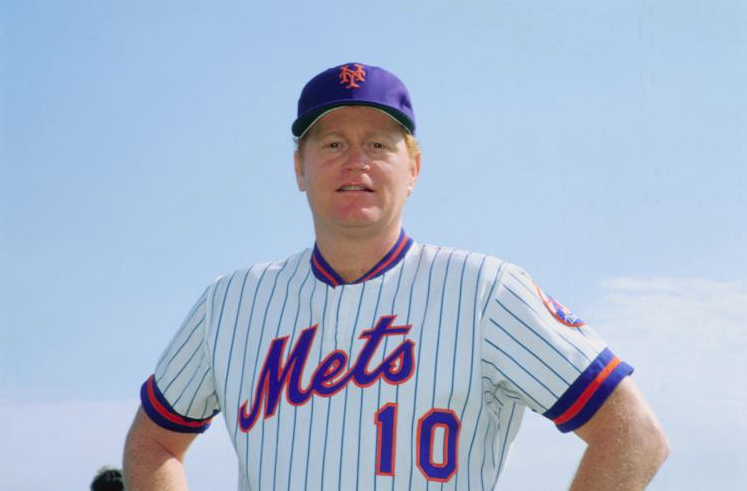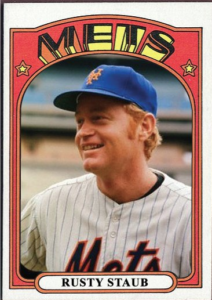For most of us, it’s Opening Day, but for Rusty Staub, “Le Grand Orange,” who was a star for the Houston Astros, the Montreal Expos, and the New York Mets, recorded his last out, dying of a heart attack in West Palm Beach, Florida. He was 73.
 Rusty, born Daniel Joseph Staub in New Orleans on April 1, 1944, brought joy, and a head of bright red hair, wherever he played. Arriving in the big leagues in 1963 for the second-season of the expansion Houston Colt 45’s (they did not take the name “Astros”—in honor of the NASA’s mission control—until 1965, when they moved into the Astrodome), he hit in the mid-.200’s. But in 1967, his average improved to .333, with 182 hits (including a league-leading 44 doubles). Traded to the Expos just before the start of their inaugural season, he became the expansion team’s first star, endearing himself to the city by learning French so he could interact with the fans . He had also added some power to his keen batting eye, clocking 78 homers in his three seasons with the team.
Rusty, born Daniel Joseph Staub in New Orleans on April 1, 1944, brought joy, and a head of bright red hair, wherever he played. Arriving in the big leagues in 1963 for the second-season of the expansion Houston Colt 45’s (they did not take the name “Astros”—in honor of the NASA’s mission control—until 1965, when they moved into the Astrodome), he hit in the mid-.200’s. But in 1967, his average improved to .333, with 182 hits (including a league-leading 44 doubles). Traded to the Expos just before the start of their inaugural season, he became the expansion team’s first star, endearing himself to the city by learning French so he could interact with the fans . He had also added some power to his keen batting eye, clocking 78 homers in his three seasons with the team.
 Although he arrived in New York in 1972, he played an unknowing part of the Mets’ miracle 1969 season. The trade that sent Staub to the Expos also sent slugging first baseman Donn Clendenon to the Astros. Clendenon refused to join the Astros, having clashed with their manager in the past. He was dealt to the Mets later that season, becoming a major part of their Cinderella championship. He became a fan favorite in New York, helping the team to its second National League Pennant, banging three home runs in the series against Cincinnati’s Big Red Machine. He set a club record for RBIs in 1975, knocking in 105 runs. Traded to the Detroit Tigers after that season, he was a designated hitter, returning to the Mets in 1980, where he played the next five seasons, mostly as a pinch hitter.
Although he arrived in New York in 1972, he played an unknowing part of the Mets’ miracle 1969 season. The trade that sent Staub to the Expos also sent slugging first baseman Donn Clendenon to the Astros. Clendenon refused to join the Astros, having clashed with their manager in the past. He was dealt to the Mets later that season, becoming a major part of their Cinderella championship. He became a fan favorite in New York, helping the team to its second National League Pennant, banging three home runs in the series against Cincinnati’s Big Red Machine. He set a club record for RBIs in 1975, knocking in 105 runs. Traded to the Detroit Tigers after that season, he was a designated hitter, returning to the Mets in 1980, where he played the next five seasons, mostly as a pinch hitter.
During his second stint in New York, he opened up Rusty’s, a popular bbq and southern restaurant. He could be seen there often during the off-season, where his warmth and  appreciation for the fans was apparent. To a teenaged Met fan, meeting Staub was a real thrill, even more than getting the chance to shake Mickey Mantle’s hand at his eponymous place on Central Park South. Never got to see him in his prime, he was more legend that man, a monument in Yankee Stadium’s center field. He shook your hand, and it was on to the next person. Staub, on the other hand, was approachable, lighting up when you told him of some game you saw him hit a homer or make a great play on the field. His restaurant really was his place, not a saloon where he licensed his name.
appreciation for the fans was apparent. To a teenaged Met fan, meeting Staub was a real thrill, even more than getting the chance to shake Mickey Mantle’s hand at his eponymous place on Central Park South. Never got to see him in his prime, he was more legend that man, a monument in Yankee Stadium’s center field. He shook your hand, and it was on to the next person. Staub, on the other hand, was approachable, lighting up when you told him of some game you saw him hit a homer or make a great play on the field. His restaurant really was his place, not a saloon where he licensed his name.
He remained part of the New York scene even after he retired at the end of the 1985 season, easily segueing to a seat in the Mets’ broadcast booth, providing insight and mischievous sense of humor alongside Tim McCarver and Ralph Kiner, a murderer’s row of great players and talkers. Staub was also known for his charity work, creating the Rusty Staub Foundation, and the New York Police and Fire Widows’ and Children’s Benefit Fund, He was a spectator at a infamous 1989 wine auction that included a rare bottle of 1787 Château Margaux that was once owned by Thomas Jefferson and valued at over $200,000 . When wine merchant William Sokolin was showing off the bottle to Staub, he knocked it into a chair, breaking it, and losing the wine.
He ended his 23-year career a six-time All Star, with a .279 batting average, with 292 home runs and 1,466 runs batted in. When his death was announced this morning, the Mets included a moment of silence in his memory to their opening day festivities.

Leave a Reply